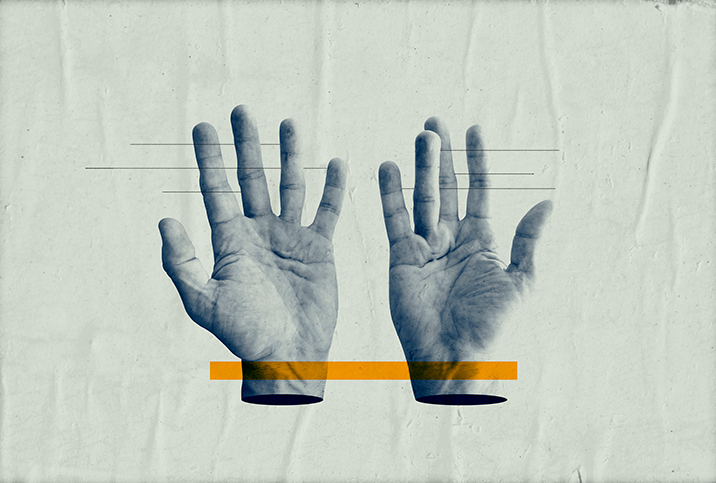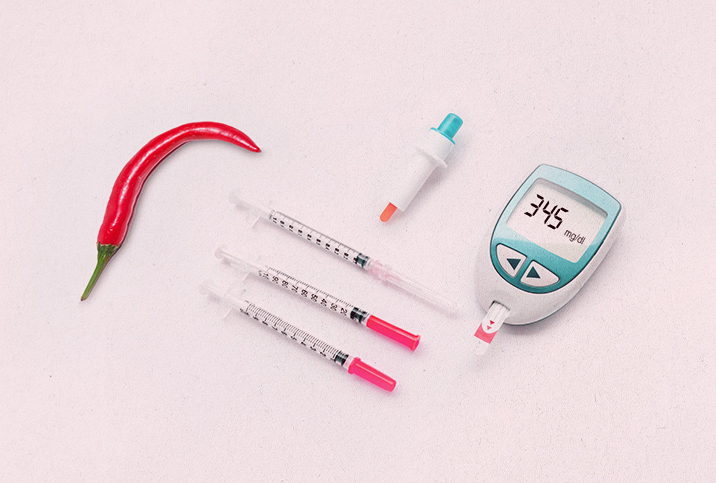The Link Between Peyronie's Disease and Dupuytren's Contracture

If you are experiencing a curvature, indentation or deformity of your penis, there's a chance your hands may be affected as well.
A 2011 study found about 22 percent of men with Peyronie's disease also have Dupuytren's contracture, a condition that affects the connective tissue underneath the skin in the palm and fingers.
Interestingly, the reverse association is not as great, as men with Dupuytren's have only a 5 percent to 8 percent chance of having Peyronie's, according to Prosper Benhaim, M.D., the chief of hand surgery at UCLA Health in Los Angeles.
Peyronie's, which is marked by a curvature of the penis and painful erections caused by the buildup of scar tissue, can directly affect a person's sexual health. If the curvature is too pronounced to engage in intercourse or an erection is painful enough to be a turnoff, a man's sex life—and potentially, his overall quality of life—can suffer, which can lead to mental health issues and relationship problems.
Benhaim, who has treated thousands of patients with Dupuytren's during the past 25 years, said the progressive hand condition is about five to eight times more common in men than in women. However, by age 80, the incidence balances.
While the exact causes of Peyronie's disease and Dupuytren's contracture are unknown, the disorders tend to run in families. Researchers believe some men have a genetic predisposition, as the gene clusters associated with tissue and wound healing seem to be abnormally expressed in men with these conditions.
Associations between Peyronie's and Dupuytren's
Benhaim and Jesse Mills, M.D., the director of the Men's Clinic at UCLA and a urologist who treats men with Peyronie's, often refer patients to each other.
Mills asks every man he treats for Peyronie's if they have any hand issues or if anyone in their family does.
"Most dads aren't going to talk about their bent penis at the Thanksgiving dinner table with their sons," Mills said. "But they certainly will talk about and show them their crooked hand. It's a nice prescreening question for me to get a family history when not everyone is quite so forthcoming with their penile anatomy. The hand is just sitting out there, easy to look at and easy to see if your dad or brothers have Dupuytren's contracture as well."
Benhaim said genetics is the most important risk factor for Dupuytren's, but diabetes, alcoholic liver disease, seizure medications and HIV have also been shown to increase a man's risk. Dupuytren's most commonly affects white men of Northern European descent. It's rare in African, South American and Asian populations.
Other conditions associated with Peyronie's include Ledderhose disease—it affects the plantar fascia in the feet—and adhesive capsulitis, or "frozen shoulder," which is characterized by pain and loss of motion in the shoulder.
"These are all collagen deficiencies, and the name and the morbidity just depends on the real estate," Mills said. "If a guy had to pick any one of those locations, most would pick anywhere but their penis. Unfortunately, it's the same tissue disruption and wound healing disorder that we see across all those different body parts."
Laurence Levine, M.D., a professor of urology at Rush University Medical Center in Chicago, sees more than 20 men with Peyronie's each week. He said his numbers for men with Peyronie's who also have a history of Dupuytren's are not as high as the aforementioned 22 percent, but the rate is probably in the 3 percent to 5 percent range.
"It's not that common, but they do fly together," he said. "I've rarely had what I call the trifecta: Dupuytren's, Peyronie's and Ledderhose."
Levine added that researchers are conducting genetic studies to try to identify which genes are responsible for this abnormal scarring response. He said that while it's interesting from a scientific perspective, it doesn't help him clinically.
"What are you going to do with that information? There's nothing we can do to prevent it," he explained. "We just have to wait and see whether you develop it or not."
Symptoms of Dupuytren's
Dupuytren's contracture is characterized by decreased hand function caused by contractures—thickening and tightening of the tissue—and painful fascial nodules.
Benhaim said Dupuytren's typically starts with a nodule or pitting in the palm. Sometimes it's a linear cord, and when it's a nodule, it's rounder.
"Think of it like a string with some pearls on it," he explained. "Sometimes it's the string. Sometimes it's the pearls. Sometimes it's both."
How the disease presents, and the rate at which it develops, varies widely from patient to patient.
Sometimes the first manifestation is a knuckle pad—a noncancerous growth—along the back of the proximal interphalangeal (PIP) joint, the middle joint of the finger.
"At that stage, people still have the ability to extend their fingers," Benhaim said. "As it progresses, the cords become predominant and they have collagen in them. But it turns out the collagen eventually thickens and shortens. As it shortens, it makes the rope shorter."
The "rope" is connected to the palm and the finger, so as it shortens, it brings the finger down. Sometimes the contractures can be mild, while other times they can be severe to the point of causing functional difficulty.
"What people commonly complain of when it's a moderate to severe contracture is they can't wash their face because their finger pokes their eye," Benhaim explained. "If your finger is sitting in your palm, there's the awkwardness of shaking hands in public when you can't get your fingers straight."
A severe contracture can make it difficult to grip a glass of water. Approximately 85 percent of the time, Dupuytren's involves the ring finger; 55 percent of the time, it's the small finger; and 25 percent of the time, it's the middle finger. The thumb and index finger are far less commonly affected.
"It may take years for a contracture to become severe," said Anna Pavlov, M.D., a plastic surgeon at Memorial Hospital in Gulfport, Mississippi. "It will worsen over time, but it can take a long time. However, the younger you are when you start to develop nodules and cords, the faster the disease will progress. In other words, if you start to develop cords and nodules in your 40s, the disease does tend to progress faster than someone who develops cords or nodules in their 70s."
Treatment options for Dupuytren's
Although there is no cure for Dupuytren's, it is usually not painful, and there are several treatment options.
Xiaflex is a minimally invasive, nonsurgical treatment that can be used for both Dupuytren's and Peyronie's. Xiaflex is an enzyme (collagenase clostridium histolyticum) that breaks down collagen found in scar tissue. To treat Dupuytren's, the medication is injected into the cord of the hand.
"Instead of a frayed rope, it now makes it a mushy rope," Benhaim said. "It really digests it, kind of like a meat tenderizer."
After the injection, treatment goes as follows:
- The patient returns to the doctor a few days after the injection.
- They are given a local anesthetic.
- The provider stretches the fingers, "rupturing the mushy rope," Benhaim explained.
Treatment is performed in the office, and patients have a much quicker recovery time than they would with a fasciectomy, the surgical procedure for Dupuytren's that removes the fascia.
Patients can regain full use of their hand within a few weeks after an injection, as opposed to the three or four months it would take after surgery. However, the recurrence rate, which ranges from 20 percent to 70 percent, is higher than with surgery, Benhaim said.
A fasciectomy involves making incisions in the fingers and the palm of the hand and surgically removing the diseased cord and affected skin. This may require more intense wound care and postoperative hand therapy.
There's also a technique called needle aponeurotomy, which involves placing a needle into the cord and rupturing it with the sharp edge of the needle. The procedure is performed with the patient under local anesthesia in a clinic. The five-year recurrence rate for needle aponeurotomy is approximately 85 percent, Pavlov said.
Deciding whether or not to treat
The most common test doctors perform when deciding whether to treat Dupuytren's is the "tabletop test."
"If a patient can place his hand flat on a table, then no surgery is needed," Pavlov said. "If you are not able to lay your palm flat on a table, then it's time to seek treatment before it gets worse."
Most insurance companies require a minimum of 20 degrees of contracture at the PIP or the metacarpophalangeal (MP) joint—the large joint at the base of each finger—for Xiaflex treatment, Benhaim said. The indication for surgery is 20 to 30 degrees of contracture.
Trauma to the hand can exacerbate the onset or the progression of Dupuytren's.
"Let's say a guy comes in with a minor contracture, five degrees, and he's got a little nodule in his palm," Benhaim said. "The surgical trauma of a kitchen knife is no different than the surgical trauma of my knife; to the body, it's the same thing. And so what I like to say to patients is if you treat this early disease, the risk is greater than the benefit. You might win the battle but lose the war."
If Benhaim takes out the nodule going to the ring finger, for instance, he may "poke a sleeping bear" and turn on the Dupuytren's in the middle and small finger adjacent to that ring finger. This can make the patient's condition worse.
In general, if the patient has less than 20 degrees of contracture, the risk is greater than the benefit. If someone is at 40 or 50 degrees, the benefit is greater than the risk. Ultimately, the choice varies by patient.
"Everybody has a different tolerance for what they want to accept," Benhaim said.
Mills recommended men with Peyronie's or Dupuytren's live their life without worrying about what tomorrow may bring.
"The last thing I want to do is fill a guy's head with anxiety if they have a little knuckle [pad] or a scar in their hand thinking that tomorrow might be the day they wake up with Peyronie's," he said.
And if that does happen, Mills wants men to know there are effective treatments available.
"Find someone who's a champion in the field who wants to do everything to help your life return to some degree of normalcy," he said.


















